1_axio基本使用和json-server 搭建REST API 服务端
1. 自己创建一个API
1.1 API 的分类
通过链接请求访问服务端进行增删改查等待操作就是api。webApi就是单纯的没有页面,只是一个用来接收请求的后台服务器,根据用户(浏览器)发送的请求进行不同的操作。
-
REST API: restful (Representational State Transfer (资源)表现层状态转化)
(1) 发送请求进行CRUD 哪个操作由请求方式来决定
(2) 同一个请求路径可以进行多个操作
(3) 请求方式会用到GET/POST/PUT/DELETE -
非REST API: restless
(1) 请求方式不决定请求的CRUD 操作
(2) 一个请求路径只对应一个操作
(3) 一般只有GET/POST
1.2 使用json-server 搭建REST API
1.2.1 json-server 是什么?
用来快速搭建REST API 的工具包。
因为需要一个后台服务端环境,用来接收我们前端页面里发送的请求,所以json-server可以很方便为我们搭建一个api服务端。
1.2.2 使用json-server搭建服务端
-
下载: npm install -g json-server
-
目标根目录下创建“数据库” json 文件: db.json。db代表数据库的意思,用json-server创建的后台服务端用来模拟数据库,存放前端用户的数据,不是真的数据库。里面内容格式如下:
{
"posts": [
{ "id": 1, "title": "json-server", "author": "typicode" },
{ "id": 2, "title": "海贼王", "author": "尾田荣一郎" }
],
"comments": [
{ "id": 1, "body": "some comment", "postId": 1 },
{ "id": 2, "body": "一些xxx评论", "postId": 2 }
],
"profile": { "name": "typicode" }
}
- 启动服务器执行命令: json-server --watch db.json 如果启动不了就用管理员身份运行vscode或者在命令前加 npx
1.2.3 使用浏览器访问测试
使用浏览器直接在地址栏输入路由即可。如:
json-server的路由规则如下:
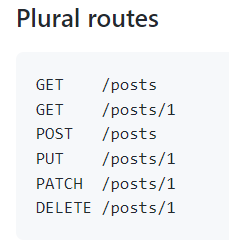
1.2.4 使用axios 访问测试
创建一个网页进行访问测试
<!DOCTYPE html>
<html lang="en">
<head>
<meta charset="UTF-8">
<meta name="viewport" content="width=device-width, initial-scale=1.0">
<meta http-equiv="X-UA-Compatible" content="ie=edge">
<title>Document</title>
</head>
<body>
<div>
<button onclick="testGet()">GET请求</button>
<button onclick="testPost()">POST请求</button>
<button onclick="testPut()">PUT请求</button>
<button onclick="testDelete()">DELETE请求</button>
</div>
<script src="https://cdn.bootcdn.net/ajax/libs/axios/0.21.1/axios.js"></script>
<script>
function testGet() {
axios.get('http://localhost:3000/posts') // 返回一个数组,数组里有两个对象
// axios.get('http://localhost:3000/posts/1') // 返回一个对象
// axios.get('http://localhost:3000/posts?id=1') // 返回一个数组,数组里有一个对象
.then(response => {
console.log('/posts get', response.data)
})
}
function testPost() { // 添加数据
axios.post('http://localhost:3000/posts', {"title": "json-server3", "author": "typicode" })
.then(response => {
console.log('/posts put', response.data)
})
//或者这样写:
//发送ajax请求
// axios({
// //请求类型
// method:"POST",
// //URL
// url:"http://127.0.0.1:3000/posts",
// //设置请求体
// data:{
// title:"今天天气真晴朗",
// author:"小张"
// }
// }).then(response=>{
// console.log(response);
// });
}
function testPut() { // 更新数据
axios.put('http://localhost:3000/posts/3', {"title": "json-server_put", "author": "typicode" })
.then(response => {
console.log('/posts post', response.data)
})
}
function testDelete() { // 删除数据
axios.delete('http://localhost:3000/posts/3')
.then(response => {
console.log('/posts delete', response.data)
})
}
</script>
</body>
</html>
2. XHR 的 ajax 封装 (简单版axios)
2.1 特点
- 函数的返回值为promise, 成功的结果为response, 失败的结果为error
- 能处理多种类型的请求: GET/POST/PUT/DELETE
- 函数的参数为一个配置对象
{
url: '', // 请求地址
method: '', // 请求方式GET/POST/PUT/DELETE
params: {}, // GET/DELETE 请求的 query 参数
data: {}, // POST/PUT 请求的请求体参数
}
- 响应 json数据 自动解析为 js的对象/数组
2.2 编码实现
function axios({
url,
method='GET',
params={},
data={}
}){
// 返回一个promise对象
return new Promise((resolve, reject) => {
// 处理method 转大写
method = method.toUpperCase();
// 处理 query参数(拼接到url上)id=1&xxx=abc
let queryString = '';
Object.keys(params).forEach(key => {
queryString += `${key}=${params[key]}&`
});
if(queryString){
// 去除最后的'&'
queryString = queryString.substring(0, queryString.length-1)
// 接到url
url += '?' + queryString
}
// 1. 执行异步Ajax请求
// 创建xhr对象
const request = new XMLHttpRequest();
// 打开连接(初始化请求,没有请求)
request.open(method, url, true);
// 发送请求
if(method === 'GET' || method === 'DELETE'){
request.send()// undefined
} else if (method === 'POST' || method === 'PUT'){
// 设置请求头,告诉服务器请求体的格式是json
request.setRequestHeader('Content-Type', 'appliaction/json;charset=utf-8');
// 发送json格式请求参数
request.send(JSON.stringify(data)); // 异步执行
}
// 绑定状态改变的监听
request.onreadystatechange = function() { // 同步执行
// 如果请求没有完成,直接结束
if (request.readyState !== 4) {
return;
}
// 如果响应状态码在[200, 300)之间代表成功,否则失败
const {status, statusText} = request
if( status>= 200 && status<=299) {// 2.1 如果请求成功,调用resolve()
// 准备结果数据对象response
const response = {
data: JSON.parse(request.response),
status,
statusText
};
resolve(response);
} else {// 2.2 如果请求失败,调用reject()
reject(new Error('request error status is ' + status));
}
}
})
}
2.3 使用测试
// 1. GET请求:从服务器端获取数据
function testGet() {
axios({
url: 'http://localhost:3000/posts',
method: 'GET',
params:{
id: 1,
xxx: 'abc'
}
}).then(
response => {
console.log(response)
},
error => {
alert(error.message)
}
)
}
// 2. POST请求:向服务器端添加数据
function testPost() {
axios({
url: 'http://localhost:3000/posts',
method: 'POST',
data: {
"title": "json-server_post",
"author": "typicode_post"
}
}).then(
response => {
console.log(response)
},
error => {
alert(error.message)
}
)
}
// 3. PUT请求:服务器更新数据
function testPut() {
axios({
url: 'http://localhost:3000/posts/1',
method: 'PUT',
data: {
"title": "json-server_put",
"author": "typicode_put"
}
}).then(
response => {
console.log(response)
},
error => {
alert(error.message)
}
)
}
// 3. DELETE请求:服务器删除数据
function testDelete() {
axios({
url: 'http://localhost:3000/posts/2',
method: 'delete'
}).then(
response => {
console.log(response)
},
error => {
alert(error.message)
}
)
}
3 axios 的理解和使用
3.1 axios 是什么?
axios是基于promise的http客户端,可以在浏览器和node.js这两个环境去运行。浏览器端借助axios可以向服务端发送ajax请求。axios也可以在nodejs中运行,向远端服务器发送http请求。
简单理解就是一个进化版的ajax。虽然底层还是用的XMLHttpRequest模块。
- 前端最流行的 ajax请求库
- react/vue 官方都推荐使用 axios 发ajax 请求
- 文档: https://github.com/axios/axios
目前axios有如下五种引用方法:
可以下载安装,或者在页面中直接用script标签引用在线包。
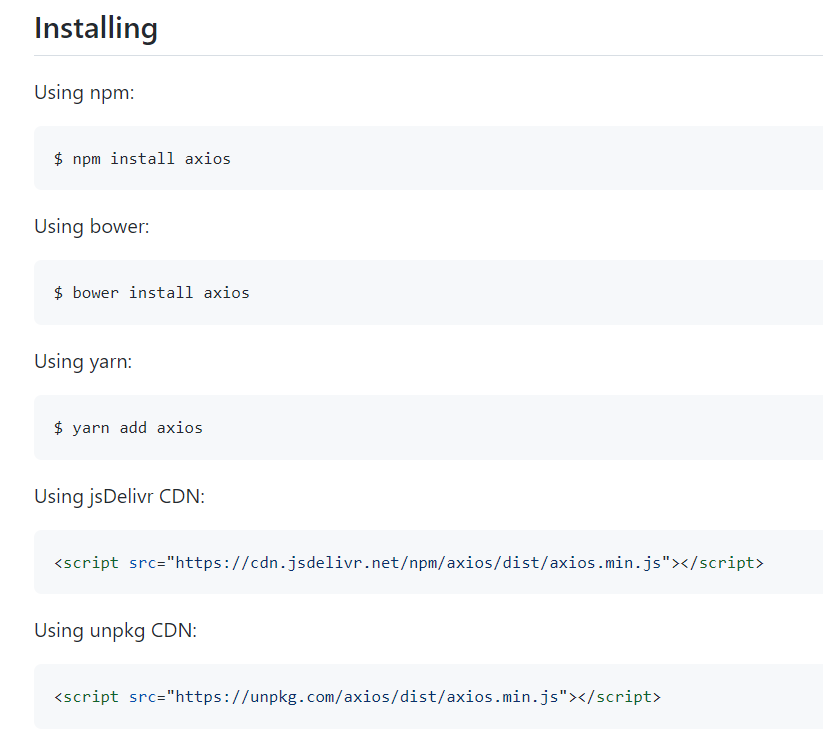
3.2 axios 特点
- 基于 xhr + promise 的异步 ajax请求库
- 浏览器端/node 端都可以使用
- 支持请求/响应拦截器
- 支持请求取消
- 请求/响应数据转换
- 批量发送多个请求
3.3 axios 常用语法
axios(config): 通用/最本质的发任意类型请求的方式
axios(url[, config]): 可以只指定url 发get 请求
axios.request(config): 等同于axios(config)
axios.get(url[, config]): 发get 请求
axios.delete(url[, config]): 发delete 请求
axios.post(url[, data, config]): 发post 请求
axios.put(url[, data, config]): 发put 请求
axios.defaults.xxx: 请求的默认全局配置(method\baseURL\params\timeout…)
axios.interceptors.request.use(): 添加请求拦截器
axios.interceptors.response.use(): 添加响应拦截器
axios.create([config]): 创建一个新的axios(它没有下面的功能)
axios.Cancel(): 用于创建取消请求的错误对象
axios.CancelToken(): 用于创建取消请求的 token 对象
axios.isCancel(): 是否是一个取消请求的错误
axios.all(promises): 用于批量执行多个异步请求
axios.spread(): 用来指定接收所有成功数据的回调函数的方法

3.4 axios请求的响应体的结构
可以在控制台输出响应返回的对象包括什么内容:
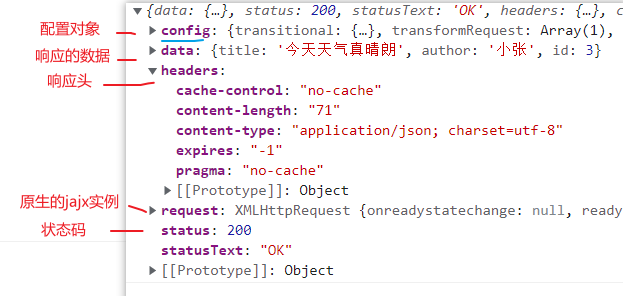
request是原生的ajax请求对象,也就是XMLHttpRequest。request属性所保存的就是axios在发送请求时所创建的ajax对象(XMLHttpRequest的实例)。
3.5 axios请求的配置对象config
也就是下面图的部分:配置属性都包括method、url、data等等,具体可以查看官网。
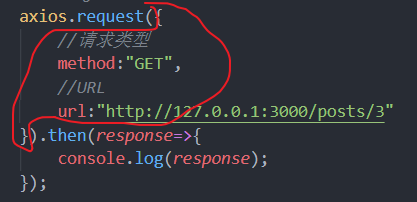
3.6 axios请求的配置对象config的默认配置
通过默认配置就可以设置axios的配置信息,如果不设置,每个都要设置,比较麻烦,如下图:
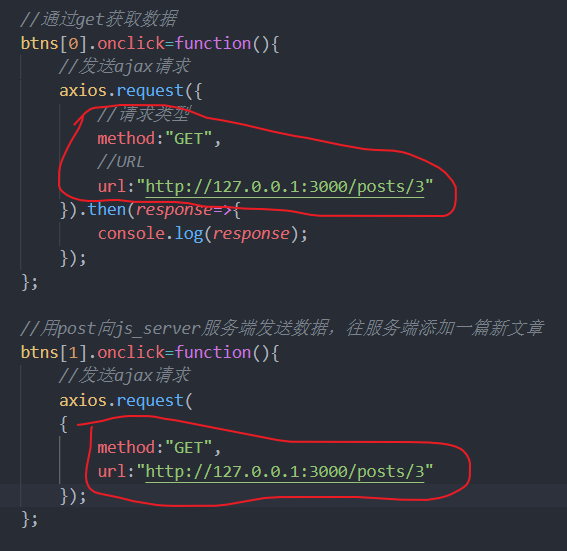
进行默认设置后就可以省略写每个请求的配置对象的信息了:具体可以查看官网。

3.7 axios创建实例对象发送请求
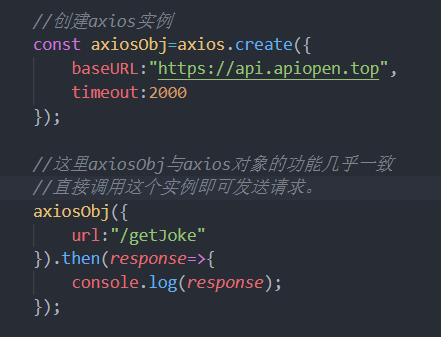
3.8 axios拦截器
- 拦截器(过滤器):就是一些函数,拦截器分为请求拦截器和响应拦截器。
- 请求拦截器:在发送请求之前,可以借用一些函数对请求参数和内容进行检测处理。如果过检测未通过可以取消发送这次请求。
- 响应拦截器:当服务器返回响应时,可以通过回调函数处理响应结果。那么,响应拦截器可以在这些回调函数处理结果之前,先对结果进行预处理操作。
- 拦截器原理是Promise的then函数实现的,都是传两个匿名函数作为参数,一个成功的,一个失败的。
拦截器的执行流程:先执行请求拦截器,再执行响应拦截器,最后执行自己自定义的失败的回调。
在script里创建一个拦截器:
// 设置添加一个请求拦截器,config就是请求的配置对象
axios.interceptors.request.use(function (config) {
// 成功时进行的操作
console.log("请求拦截器--成功状态");
return config;
}, function (error) {
// 失败时进行的操作
console.log("请求拦截器--失败状态");
return Promise.reject(error);
});
// 设置添加一个响应拦截器
axios.interceptors.response.use(function (response) {
console.log("响应拦截器--成功状态");
return response;
}, function (error) {
console.log("响应拦截器--失败状态");
return Promise.reject(error);
});
//发送请求
axios({
method:"GET",
url:"http://127.0.0.1:3000/posts"
}).then(response=>{
console.log("成功的自定义回调函数执行");
//console.log(response);
});
上面代码执行流程:
先执行请求拦截器,服务器响应后执行响应拦截器,最后执行自己的请求的回调函数。
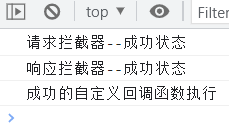
将上面请求拦截器里返回一个失败的promise状态,那么这个拦截器的整体状态就是失败,但是拦截器的回调里面不进行取消请求操作。
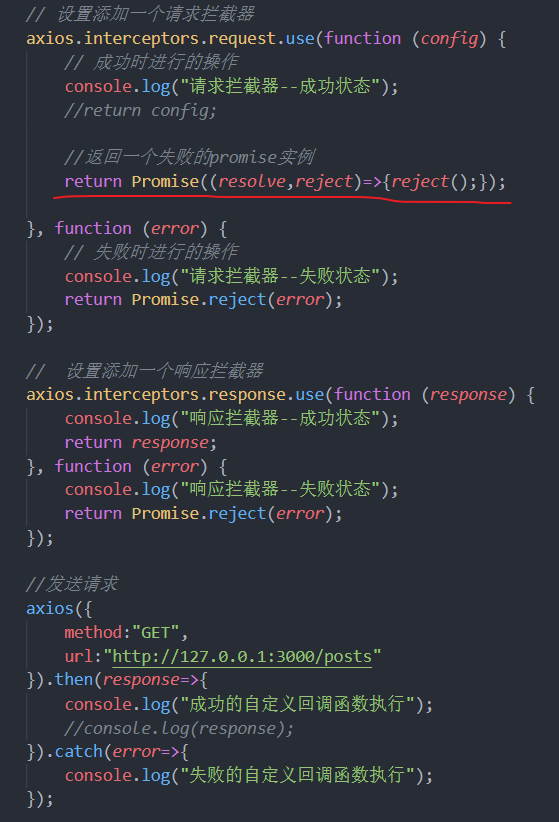
上面图的代码运行结果:

3.9 取消请求
通过给cancelToken属性添加 new axios.CancelToken的实例,外面调用即可取消。
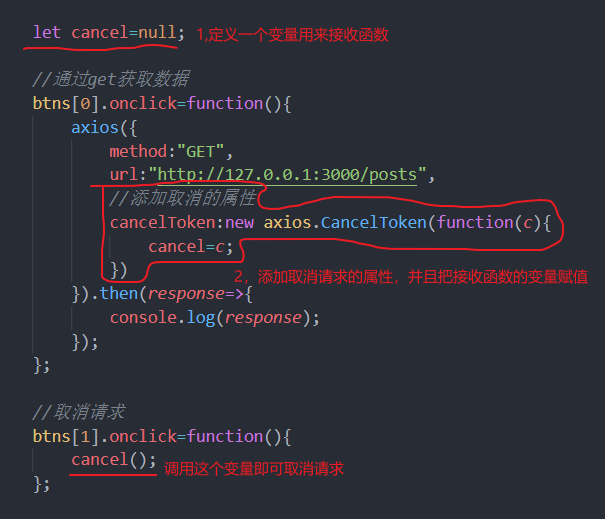
4 难点语法的理解和使用
4.1 axios.create(config)
-
根据指定配置创建一个新的 axios, 也就是每个新 axios 都有自己的配置
-
新 axios 只是没有取消请求和批量发请求的方法, 其它所有语法都是一致的
-
为什么要设计这个语法?
(1) 需求: 项目中有部分接口需要的配置与另一部分接口需要的配置不太一样, 如何处理(比如有多个baseURL需要指定)
(2) 解决: 创建2 个新axios, 每个都有自己特有的配置, 分别应用到不同要求的接口请求中
const instance = axios.create({ // instance是函数类型
baseURL: 'http://localhost:3000'
})
// 使用instance发Ajax请求
instance({
url: '/posts'
})
instance.get('/posts')
4.2 拦截器函数/ajax 请求/请求的回调函数的调用顺序
- 说明: 调用axios()并不是立即发送ajax 请求, 而是需要经历一个较长的流程
- 流程: 请求拦截器2 => 请求拦截器1 => 发ajax 请求 => 响应拦截器1 => 响应拦截器2 => 请求的回调
- 注意: 此流程是通过 promise 串连起来的, 请求拦截器传递的是config, 响应拦截器传递的是response
// 添加两个请求拦截器(回调函数)
axios.interceptors.request.use(
config => {
console.log('request interceptor1 onResolved()') // -----------2
return config
},
error => {
console.log('request interceptor1 onRejected()')
return Promise.reject(error)
}
)
axios.interceptors.request.use(
config => {
console.log('request interceptor2 onResolved()') // -----------1
return config
},
error => {
console.log('request interceptor2 onRejected()')
return Promise.reject(error)
}
)
// 添加两个响应拦截器
axios.interceptors.response.use(
resopnse => {
console.log('response interceptor1 onResolved()') // -----------3
return resopnse
},
error => {
console.log('response interceptor1 onRejected()')
return Promise.reject(error)
}
)
axios.interceptors.response.use(
resopnse => {
console.log('response interceptor2 onResolved()') // -----------4
return resopnse
},
error => {
console.log('response interceptor2 onRejected()')
return Promise.reject(error)
}
)
axios.get('http://localhost:3000/posts')
.then(response => {
console.log('data', response.data) //data Array(4) -------------5
})
.catch(error => {
cosole.log('error', error.message)
})
// request interceptor2 onResolved()
// request interceptor1 onResolved()
// response interceptor1 onResolved()
// response interceptor2 onResolved()
// data Array(4)
4.3 取消请求
1. 基本流程
- 配置 cancelToken 对象
- 缓存用于取消请求的 cancel 函数
- 在后面特定时机调用 cancel 函数取消请求
- 在错误回调中判断如果 error 是 cancel, 做相应处理
2. 实现功能
用express先搭建一个有延迟的服务器
const express = require('express')
const cors = require('cors')
const app = express()
// 使用cors, 允许跨域
app.use(cors())
// 能解析urlencode格式的post请求体参数
app.use(express.urlencoded())
// 能解析json格式的请求体参数
app.use(express.json())
app.get('/products1', (req, res) => {
setTimeout(() => {
res.send([
{id: 1, name: 'product1.1'},
{id: 2, name: 'product1.2'},
{id: 3, name: 'product1.3'}
])
}, 1000 + Math.random()*2000);
})
app.get('/products2', (req, res) => {
setTimeout(() => {
res.send([{
id: 1,
name: 'product2.1'
},
{
id: 2,
name: 'product2.2'
},
{
id: 3,
name: 'product2.3'
}
])
}, 1000 + Math.random() * 2000);
})
app.listen(4000, () => {
console.log('server app start on port 4000')
})
- 点击按钮, 取消某个正在请求中的请求
let cancel // 用于保存取消请求的函数
function getProducts1() {
axios({
url: 'http://localhost:4000/products1',
cancelToken: new axios.CancelToken(function executor(c){ // c是用于取消当前请求的函数
// 保存取消函数,用于之后可能需要取消当前请求
cancel = c;
})
}).then(
response => {
cancel = null
console.log('请求1成功了', response.data)
},
error => {
cancel = null
console.log('请求1失败了', error.message, error) // 请求1失败了 强制取消请求 Cancel {message: "强制取消请求"}
}
)
}
function getProducts2() {
axios({
url: 'http://localhost:4000/products2'
}).then(
response => {
console.log('请求2成功了', response.data)
}
)
}
function cancelReq() {
// alert('取消请求')
// 执行取消请求的函数
if (typeof cancel === 'function'){
cancel('强制取消请求')
} else {
console.log('没有可取消的请求')
}
}
- 在请求一个接口前, 取消前面一个未完成的请求
let cancel // 用于保存取消请求的函数
function getProducts1() {
// 在准备发请求前,取消未完成的请求
if (typeof cancel === 'function'){
cancel('取消请求')
}
axios({
url: 'http://localhost:4000/products1',
cancelToken: new axios.CancelToken(function executor(c){ // c是用于取消当前请求的函数
// 保存取消函数,用于之后可能需要取消当前请求
cancel = c;
})
}).then(
response => {
cancel = null
console.log('请求1成功了', response.data)
},
error => {
if (axios.isCancel(error)){
console.log('请求1取消的错误', error.message)
}else{ // 请求出错了
cancel = null
console.log('请求1失败了', error.message, error) // 请求1失败了 强制取消请求 Cancel {message: "强制取消请求"}
}
}
)
}
function getProducts2() {
// 在准备发请求前,取消未完成的请求
if (typeof cancel === 'function'){
cancel('取消请求')
}
axios({
url: 'http://localhost:4000/products2',
cancelToken: new axios.CancelToken(function executor(c){
cancel = c;
})
}).then(
response => {
cancel = null
console.log('请求2成功了', response.data)
},
error => {
if (axios.isCancel(error)){
console.log('请求2取消的错误', error.message)
}else{
cancel = null
console.log('请求2失败了', error.message, error)
}
}
)
}
function cancelReq() {
// alert('取消请求')
// 执行取消请求的函数
if (typeof cancel === 'function'){
cancel('强制取消请求')
} else {
console.log('没有可取消的请求')
}
}
使用拦截器改进代码,减少重复代码
// 添加请求拦截器
axios.interceptors.request.use((config) => { // 只写一个成功的回调
// 在准备发请求前,取消未完成的请求
if (typeof cancel === 'function'){
cancel('取消请求')
}
// 添加一个cancelToken的配置
config.cancelToken = new axios.CancelToken(function executor(c){ // c是用于取消当前请求的函数
// 保存取消函数,用于之后可能需要取消当前请求
cancel = c;
})
return config
})
// 添加响应拦截器
axios.interceptors.response.use(
response => { // 成功的回调
cancel = null
return response
},
error => { // 失败的回调
if (axios.isCancel(error)){ // 请求取消的错误
console.log('请求取消的错误', error.message)
// 中断promise链
return new Promise(() => {})
}else{ // 请求出错了
cancel = null
// 将错误向下传递
// throw error
return Promise.reject(error)
}
}
)
let cancel // 用于保存取消请求的函数
function getProducts1() {
axios({
url: 'http://localhost:4000/products1'
}).then(
response => {
console.log('请求1成功了', response.data)
},
error => { // 只用处理请求失败的情况,取消请求的错误不用处理
console.log('请求1失败了', error.message, error)
}
)
}
function getProducts2() {
axios({
url: 'http://localhost:4000/products2'
}).then(
response => {
console.log('请求2成功了', response.data)
},
error => {
console.log('请求2失败了', error.message, error)
}
)
}
function cancelReq() {
if (typeof cancel === 'function'){
cancel('强制取消请求')
} else {
console.log('没有可取消的请求')
}
}





【推荐】国内首个AI IDE,深度理解中文开发场景,立即下载体验Trae
【推荐】编程新体验,更懂你的AI,立即体验豆包MarsCode编程助手
【推荐】抖音旗下AI助手豆包,你的智能百科全书,全免费不限次数
【推荐】轻量又高性能的 SSH 工具 IShell:AI 加持,快人一步
· TypeScript + Deepseek 打造卜卦网站:技术与玄学的结合
· 阿里巴巴 QwQ-32B真的超越了 DeepSeek R-1吗?
· 【译】Visual Studio 中新的强大生产力特性
· 10年+ .NET Coder 心语 ── 封装的思维:从隐藏、稳定开始理解其本质意义
· 【设计模式】告别冗长if-else语句:使用策略模式优化代码结构